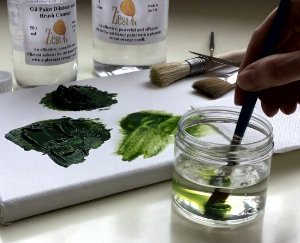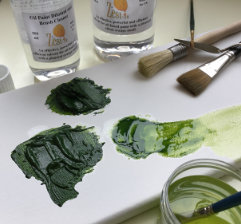|

Zest-it® Oil paint Dilutant and Brush Cleaner

Use as diluent, medium and solvent for oil based media.
Also to clean your brushes and equipment

Thin oil paint 'as thin as ink'

Product Safety Information for
Zest-it Oil Paint Dilutant and
Brush Cleaner
PDF For an unbiased testimonial of the Zest-it Oil Paint Dilutant and Brush Cleaner |
The Zest-it Oil Paint Dilutant and Brush Cleaner is a much safer solvent for oil painters than Gum Turpentine and White Spirit, it has been an excellent replacement for many years.
It does not contain any Aromatics or CFC's and it is non-flammable, non-toxic and biodegradable with low VOC's and is therefore kinder to the environment.
It can travel by road, sea and air, therefore an excellent accompaniment if you are going on a painting holiday (depending on the airline). It is re-usable, which makes it economical and a little goes a long way.Use as a diluent to thin oil paint, oil based ink and oil pastels. Excellent for blending oil pastel, oil bars and paint sticks, can be used to give a smooth finish. Thin oil paint 'as thin as ink' for under-painting a canvas or colouring a surface.
It is an excellent solvent for Gum Damar and other resin for making varnish. You may have read that only turpentine will dissolve these resins, this has not been the case for many years, so you can use it to make your own varnish if you wish.
Zest-it Brush Cleaner can be used to make a standard "5 lb cut" varnish and dilute it down to your required strength. However we would advise using the same diluent for dilution as mixing solvents could cause your varnish to go cloudy.
Use it to make a medium by mixing with Linseed Stand Oil and Cold Pressed Linseed Oil. Linseed oils are very viscous and it takes a decent amount of 'agitation' for the two products to mix together thoroughly.
Painting mediums can be a personal 'thing' and the ratio of the mix is not fixed. If you are unsure, as a suggestion, try a 50/50 mix and adjust the proportions from there.
Use for cleaning oil paint, oil colour, oil bars, oil pastels, oil based ink, Damar varnish and other oil based products from your brushes, palette, painting knives, rollers and equipment.
The Zest-it Brush Cleaner has considerable active strength, meaning it is re-usable many times for brush washing. After use allow to settle and decant off the clear liquid, this saves on waste and makes it economical in use.
If you need to dispose of unused Brush Cleaner, before throwing away ask your local art club if they could make use of it, you may do someone a good deed!
Dispose of 'paint sludge' by putting onto damp sand or soil in a container. Do not throw the liquid or brush washings down the sink.
Sizes available - 125 ml; 250 ml; 500 ml; 1 Litre.
Copyright© Jacqui Blackman 1999 A review of cleaning brushes with Zest-it Brush Cleaner
Please see this information
FAQ's Q
Can I use Zest-it Oil Paint Dilutant and Brush Cleaner with my Acrylic paints? A
Sorry no, Zest-it and water just don't mix, not for painting or cleaning brushes. For cleaning Acrylic from brush use the Zest-it Acrylic Brush Cleaner. Q
I read on the net that Zest-it is toxic, is it true? A
Zest-it is not toxic - consider the person saying it, why would they say it and how little knowledge they have. Q
Why does Zest-it have a 'Warning' notice on the label? A
It's a recorded fact that on average, there are 48,000 people a year who drink a product not meant for human consumption!
So, a 'Warning' notice on the label stating 'may cause lung damage if swallowed' is because - if the product was swallowed and the person vomited and the vomit entered the lungs, it could cause bronchopneumonia. This notice is for use by a Doctor, so he knows what action to take, should anyone swallow the product. This information has been updated. All this information is available here. Q
Can Zest-it be used to remove the 'sticky tape' used by picture framers? A
Yes it can, it has undergone numerous tests by members of the Fine Art Trade Guild. Some of the members use it constantly because it leaves no residue. Members are also testing it in other area of picture conservation. Q:
Can I mix Oils and Acrylics? A.
If by that you mean mix the two paints together, the simple answer is No. You can however do an under-painting with Acrylics and then paint Oils
over the top, this is useful if you wish to make a quick start but not necessarily of archival quality unless an acrylic emulsion
gesso is used.
Why? Acrylics are water based, when you try to paint acrylic over oils, like water on a ducks back it slides off, but this isn't always apparent at first! ******** Q.
Do I have to paint Oils on canvas? A.
No you don't, you can use just about any surface for Oils. The only recommendation is that it is suitably sealed and primed, and has a 'key' or 'tooth' for the paint to adhere to, this is very important.
You can successfully use solid supports like wood, hardboard, plywood, chipboard, tin, copper, brick, concrete, plasterboard, pottery.
Other supports include oil paper, water colour paper, illustration board, linen, muslin, silk, polyester and museum board. Plenty to choose from! ********* Q.
Can I mix water based Oils with ordinary Oils? A. Yes you can. BUT if you mix water based with traditional/ordinary oils, then you need to treat them all as ordinary oils, especially when it comes to cleaning equipment.
The modified mediums used with water based oils were designed for that purpose, and likewise the mediums for ordinary oils. *********** |

